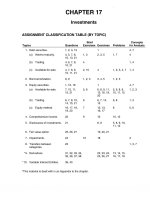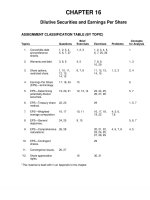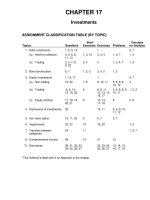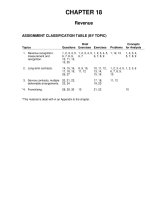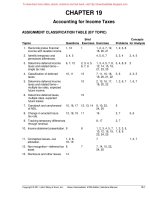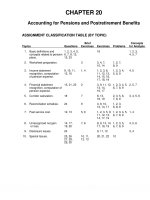Intermediate accounting IFRS 3rd ch17
Bạn đang xem bản rút gọn của tài liệu. Xem và tải ngay bản đầy đủ của tài liệu tại đây (3.65 MB, 137 trang )
Prepared by
Coby Harmon
University of California, Santa Barbara
17-1
Westmont College
CHAPTER 17
Investments
LEARNING OBJECTIVES
After studying this chapter, you should be able to:
1.
Describe the accounting for debt investments.
3.
Explain the equity method of accounting.
2.
Explain the accounting for equity investments.
4.
Evaluate other major issues related to debt and
equity investments.
17-2
PREVIEW OF CHAPTER 17
Intermediate Accounting
IFRS 3rd Edition
Kieso ● Weygandt ● Warfield
17-3
LEARNING OBJECTIVE 1
Debt Investments
Describe the accounting for debt investments.
Two Types of Financial Assets
Debt investments.
Equity investments.
Motivations for investing:
Earn a high rate of return.
To secure certain operating or financing arrangements with another company (equity
securities).
17-4
LO 1
Debt Investments
Classification and Measurement of Financial Assets
Two criteria:
17-5
1.
What is the company’s business model for managing its financial assets?
2.
What are the contractual cash flow characteristics of the financial investment?
LO 1
Classification and Measurement of Financial Assets
Summary of the classification and measurement of debt and equity investments.
ILLUSTRATION 17.1
Classification and Measurement
17-6
LO 1
A Closer Look at Debt Investments
Debt investments are characterized by contractual payments on specified dates of
principal and
interest on the principal amount outstanding.
Companies group debt investments into three categories:
17-7
1.
Held-for-collection
2.
Held-for-collection and selling
3.
Trading
LO 1
A Closer Look at Debt Investments
Companies group debt investments into three categories:
1.
Held-for-collection
2.
Held-for-collection and selling
3.
Trading
ILLUSTRATION 17.2
Accounting for Debt Investments by Category
17-8
LO 1
Debt Investment at Amortized Cost
Illustration: Robinson SA purchased €100,000 of 8 percent bonds of Evermaster AG on January 1, 2019, at
a discount, paying €92,278. The bonds mature January 1, 2024 and yield 10 percent; interest is payable each
July 1 and January 1. Robinson records the investment as follows:
January 1, 2019
Debt Investments
Cash
17-9
92,278
92,278
LO 1
Debt Investment at Amortized Cost
ILLUSTRATION 17.2
17-10
LO 1
Debt Investment at Amortized Cost
ILLUSTRATION 17.2
Robinson records the receipt of the first semiannual interest payment on July 1, 2019, as follows:
Cash 4,000
Debt Investments 614
Interest Revenue
17-11
4,614
LO 1
Debt Investment at Amortized Cost
ILLUSTRATION 17.2
Robinson is on a calendar-year basis, it accrues interest and amortizes the discount at December 31, 2019,
as follows:
Interest Receivable
4,000
Debt Investments 645
Interest Revenue
17-12
4,645
LO 1
Debt Investment at Amortized Cost
Reporting of Bond Investment at Amortized Cost
ILLUSTRATION 17.3
17-13
LO 1
ILLUSTRATION 17.2
Assume that Robinson sells its investment on November 1, 2021, at 99¾ plus accrued interest. Robinson
records this discount amortization as follows:
Debt Investments 522
Interest Revenue
522
(€783 x 4/6 = €522)
17-14
LO 1
Debt Investment at Amortized Cost
Computation Gain on Sale of Bonds
ILLUSTRATION 17.4
Cash (€99,750 + €2,667)
102,417
Interest Revenue (4/6 x €4,000)
Debt Investments
96,193
Gain on Sale of Investments
17-15
2,667
3,557
LO 1
Debt Investments—Held-for-Collection and Selling (HFCS)
Debt investments held-for-collection and selling follow the same accounting entries as debt
investments held-for-collection during the reporting period. That is, they are recorded at amortized
cost.
However, at each reporting date, companies
Adjust the amortized cost to fair value.
Any unrealized holding gain or loss is reported as part of other comprehensive income
rather than in the profit and loss statement.
17-16
LO 1
Held-for-Collection and Selling (HFCS)
Illustration: Graff plc purchases £100,000, 10 percent, five-year bonds on January 1, 2019, with interest
payable on July 1 and January 1. The bonds sell for £108,111, which results in a bond premium of £8,111 and
an effective-interest rate of 8 percent. Graff records the purchase of the bonds as follows.
January 1, 2019
17-17
Debt Investments
108,111
Cash
108,111
LO 1
ILLUSTRATION 17.6
Schedule of Interest Revenue and Bond
Premium Amortization— Effective-Interest
Method
17-18
ILLUSTRATION 17.6
Illustration (Single Security): The entry to record interest revenue on July 1, 2019, is as follows.
Cash 5,000
17-19
Debt Investments
676
Interest Revenue
4,324
LO 1
Held-for-Collection and Selling (HFCS)
Interest Revenue for 2019
= $8,621
ILLUSTRATION 17.6
Illustration (Single Security): At December 31, 2019, Graff makes the following entry to recognize interest
revenue.
Interest Receivable
17-20
5,000
Debt Investments
703
Interest Revenue
4,297
LO 1
Held-for-Collection and Selling (HFCS)
ILLUSTRATION 17.6
Illustration (Single Security): To apply the fair value method to these debt investments, assume that at December
31, 2019 the fair value of the bonds is £105,000. Graff makes the following entry.
Unrealized Holding Gain or Loss—Equity
Fair Value Adjustment
17-21
1,732
1,732
LO 1
Held-for-Collection and Selling (HFCS)
Illustration (Portfolio of Securities): Webb AG has two debt securities classified as held-for-collection and selling.
The following illustration identifies the amortized cost, fair value, and the amount of the unrealized gain or loss.
ILLUSTRATION 17.7
17-22
Computation of Fair Value Adjustment—HFCS (2019)
LO 1
Held-for-Collection and Selling (HFCS)
ILLUSTRATION 17.7
Prepare the adjusting entry Webb would make on December 31, 2019 to record the loss.
Unrealized Holding Gain or Loss—Equity
Fair Value Adjustment
17-23
9,537
9,537
LO 1
Held-for-Collection and Selling (HFCS)
Sale of HFCS Securities
If company sells bonds before maturity date:
It must make entries to remove from the Debt Investments account the amortized cost of bonds sold.
Any realized gain or loss on sale is reported in the “Other income and expense” section of the income
statement.
17-24
LO 1
Sale of HFCS Securities
Illustration: Webb AG sold the Watson bonds (from Illustration 17.7) on July 1, 2020, for £90,000, at which time it
had an amortized cost of £94,214.
ILLUSTRATION 17.8
Computation of Loss on Sale of Bonds
Cash 90,000
Loss on Sale of Investments
Debt Investments
17-25
4,214
94,214
LO 1



